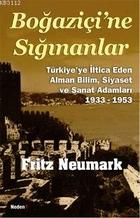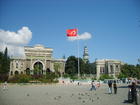 In Hitler’s Germany, scholars lost their jobs because they were Jewish or otherwise undesired.
In Hitler’s Germany, scholars lost their jobs because they were Jewish or otherwise undesired.
Turkey, on the other hand, was craving for Western scholars and tutors for its universities.
Under the leadership of Kemal Atatürk, a process of modernization had started in 1922 and all Turkish eyes were on the West.
A drastic reorganization of the universities was part of the process.
With the help of an intermediary agency residing in Switzerland, hundreds of German (and later Austrian) scholars made their way to Istanbul and Ankara after 1933.
They included physicians, lawyers, and economists, but also musicians such as Paul Hindemith, who established a conservatory in Ankara.
 The Germans undertook to learn Turkish and to invest all their energy in transferring knowledge to the Turks.
The Germans undertook to learn Turkish and to invest all their energy in transferring knowledge to the Turks.
They did so by writing manuals and setting up knowledge centres and institutions.
The scholars were appointed for a period of five years, but most Germans extended their stay until the Second World War was over. (Turkey had remained neutral.)
In the 1930s the majority of teaching staff at Turkish universities were German, and many of these were of Jewish origin. In 1939 a visiting official of the Hitler regime lamented that Istanbul University was “total verjudet” (infested with Jews).
All in all, these migrants contributed in some measure to the building of a modern Turkey.In light of current events in Turkey, this German contribution to the genesis of modern Turkey has suddenly become an issue of relevance. The sad word heimatlos was even assimilated into the Turkish language as haymatloz, both meaning “displaced” and “uprooted”.
The economist Fritz Neumark (1900-1991) emigrated in 1933 and worked at Istanbul University for twenty years. He published five manuals in Turkish and collaborated on a reform of the tax system. After the war, Neumark moved to the US, but he eventually returned to Germany. “We felt homesick for our countryside, but most of all for our language”, he wrote in Zuflucht am Bosporus, his reminiscences of this period of exile.* The language was a problem, but so, too, was the huge workload, as the university was overcrowded. The tutors had to correct a thousand written examinations taken by first-year students and hold hundreds of oral exams twice a year. But these were minor problems, as Neumark’s recollections of his stay in Turkey are predominantly positive, as were those of other migrants.**
 Traugott Fuchs, Junger Türke (wikimedia); Traugott Fuchs was a German philologist and artist who emigrated to Turkey in 1934 and stayed there until his death in 1997.
Traugott Fuchs, Junger Türke (wikimedia); Traugott Fuchs was a German philologist and artist who emigrated to Turkey in 1934 and stayed there until his death in 1997.
*Fritz Neumark, Zuflucht am Bosporus. Deutsche Gelehrte, Politiker und Künstler in der Emigration 1933-1953 (1980); Boğaziçine Sığınanlar. Türkiye'ye İltica Eden Alman Bilim, Siyaset ve Sanat Adamları 1933-1953 (2008) (to be processed)
**Philipp Schwartz, Notgemeinschaft. Zur Emigration deutscher Wissenschaftler nach 1933 in die Türkei (Marburg 1995)
Haymatloz : Exil in der Türkei 1933-1945 : eine Ausstellung des Vereins Aktives Museum und des Goethe-Institutes mit der Akademie der Künste. (Berlin 2000)
Margreet Schrevel
